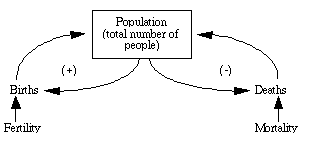|
 1. What values, structures and processes would help move us from our present dominant socioeconomic paradigm to the suggested integrist paradigm? 1. What values, structures and processes would help move us from our present dominant socioeconomic paradigm to the suggested integrist paradigm?
 2. Are there limits to the carrying capacity of the biosphere? What is the nature of these limits? Are they fixed (Rees 1992) or plastic, that is, they vary according to what societies value (Regier 1995)? 2. Are there limits to the carrying capacity of the biosphere? What is the nature of these limits? Are they fixed (Rees 1992) or plastic, that is, they vary according to what societies value (Regier 1995)?
In a research workshop at UBC, Henry Regier used a model of a simple heat pump to illustrate some of the concepts associated with carrying capacity as that concept might relate to assimilative capacity of ecosystems for harmful wastes. The heat pump was used to transfer waste heat from an external source into a closed vessel with particular physical properties (size, shape,  volume, contents, properties of the vessel walls, temperature, pressure, etc.). By analogue the closed vessel was the ecosystem of interest, absorbing the waste heat (a proxy for wastes of various kinds) resulting from human activity. volume, contents, properties of the vessel walls, temperature, pressure, etc.). By analogue the closed vessel was the ecosystem of interest, absorbing the waste heat (a proxy for wastes of various kinds) resulting from human activity.
Clearly the response to increased provision of heat to the closed vessel will vary depending on a whole set of conditions related to the physical properties listed above. The dissipative capabilities of the vessel (or natural system) appear to exist as a series of steps of different phases with respect to different features of the vessel. Some of these steps (e.g. with respect to current structure) may be fully reversible. Eventually, as heat is added, a non-reversible collapse of certain properties of the vessel occurs.
This simple model (which is of course much less complex than real ecosystems) already suggests that the concept of carrying capacity can be defined in many different ways, e.g. by limits of sustainability of particular uses of the ecosystem, by undesirable consequences of particular loadings into a system, by limits to the sustainability of certain properties of the ecosystem, etc. This in turn suggests that the definition of carrying capacity depends critically on what we as a society want. Any definitions, therefore, are inherently normative. Determining carrying capacity cannot be a simple matter of applying one definition, or determining one absolute or finite measure, but rather, must involve a complex series of interactions between the natural and cultural worlds. There is no one comprehensive picture of the totality of the overall system: moreover, natural systems, which are open, self-organizing, non-linear, and evolutionary, may not collapse initially as a result of human-induced loadings, but may flip to a completely different level or type of organization. There may well be multiple thresholds of multiple kinds.
 3. Are there limits to economic growth, given a finite carrying capacity? If there are limits, what ramifications does this have for development versus growth? 3. Are there limits to economic growth, given a finite carrying capacity? If there are limits, what ramifications does this have for development versus growth?
TO GROW means to increase in size by the assimilation or accretion of materials. TO DEVELOP means to expand or realize the potentialities of; to bring to a fuller, greater, or better state. When something grows it gets quantitatively bigger; when it develops it gets qualitatively better or at least different. Our planet develops over time without growing. (Meadows et al. 1972)
 4. How would one encourage the economic system, assuming a finite and non-growing earth, to adopt or adapt to a similar pattern of development? 4. How would one encourage the economic system, assuming a finite and non-growing earth, to adopt or adapt to a similar pattern of development?
 5. How can the concept of development replace growth as necessary for sustainable employment, social mobility, and technical advance? Is there a link, or new narrative for social change that can be made between development and progress? 5. How can the concept of development replace growth as necessary for sustainable employment, social mobility, and technical advance? Is there a link, or new narrative for social change that can be made between development and progress?
 6. What values facilitate co-evolution of natural and human systems, and what keeps the opposite in place? 6. What values facilitate co-evolution of natural and human systems, and what keeps the opposite in place?
 7. What new metaphors, myths and narratives for social change could we use to encourage the emergence of more integrist and life supporting paradigms, and what existing ones have to be changed? What are the major barriers blocking such an emergence, and what are ways to weaken or remove them? 7. What new metaphors, myths and narratives for social change could we use to encourage the emergence of more integrist and life supporting paradigms, and what existing ones have to be changed? What are the major barriers blocking such an emergence, and what are ways to weaken or remove them?
 8. What role can governments play to reduce and eliminate the psychological and institutional and structural reasons for growth, as well as the structural reasons? 8. What role can governments play to reduce and eliminate the psychological and institutional and structural reasons for growth, as well as the structural reasons?
(Introduce barriers model here)
 9. What is the impact of finite limits on human carrying capacity? Is it possible to absolutely determine these limits, given the differences in competing paradigms, economically and ecologically as referenced in question 2? 9. What is the impact of finite limits on human carrying capacity? Is it possible to absolutely determine these limits, given the differences in competing paradigms, economically and ecologically as referenced in question 2?
For example, Daly views the crux of the issue as the positioning of the economy as an isolated system, or an open subsystem of a finite system. If the former, then there is no environment to constrain its continual growth. But, if we see the economic system as a subsystem of a larger, but finite and non-growing system, then obviously its growth is limited. The economy may continue to develop qualitatively, but it cannot continue to grow quantitatively; beyond some point it must approximate a steady state in its physical dimensions. The majority of mainstream economist and government policy analysts share the former view.
 10. In your opinion, where are human systems in terms of their appropriation of the biosphere depicted in Figure 4, and on what do you base your opinion? 10. In your opinion, where are human systems in terms of their appropriation of the biosphere depicted in Figure 4, and on what do you base your opinion?
 11. Is there any way to model these scenarios in a way that would be meaningful to politicians and senior-level bureaucrats? 11. Is there any way to model these scenarios in a way that would be meaningful to politicians and senior-level bureaucrats?
 12. What structures and processes from natural systems should be incorporated into human systems, and why? 12. What structures and processes from natural systems should be incorporated into human systems, and why?

 13. What ecosystem principles should be incorporated into human systems, and why? 13. What ecosystem principles should be incorporated into human systems, and why?
Examples of some ecosystem principles are: integrity, resilience, dynamic equilibrium, evolutionary pathways, self-organizing open and holarctic systems.
 14. How can a sense of ecological time be reconciled with the short-term time frame of political decision-making? 14. How can a sense of ecological time be reconciled with the short-term time frame of political decision-making?
 15. How do you integrate time, place and scale phenomena of ecosystems into human decision-making? 15. How do you integrate time, place and scale phenomena of ecosystems into human decision-making?
 16. Is there a way to redesign government information systems so that feedback loops from natural systems are systematically incorporated into decision-making, delays and lags reduced or eliminated, and policy changes dynamically responsive? 16. Is there a way to redesign government information systems so that feedback loops from natural systems are systematically incorporated into decision-making, delays and lags reduced or eliminated, and policy changes dynamically responsive?
For example:

On the left is a positive loop that accounts for the exponential growth. The larger the population, the more babies will be born each year. The more babies, the larger the population. After a delay while these babies grow up and become parents, even more babies can be born, swelling the population further.
On the right is a negative feedback loop that governs population growth. Whereas positive loops generate runaway growth, negative feedback loops tend to regulate growth, to hold a system within some acceptable range, to return it to a stable state.
(Meadows et al. 1992)
 17. How can human bounded systems, such as federal/provincial jurisdictions, become more flexible to compliment unbounded ecosystems? 17. How can human bounded systems, such as federal/provincial jurisdictions, become more flexible to compliment unbounded ecosystems?
 18. What would the world be like if human beings co-opted 80% of net primary production (NPP)? Or 100%? 18. What would the world be like if human beings co-opted 80% of net primary production (NPP)? Or 100%?
 19. Are there existing transition strategies that would help in changing governmental values for sustainable development? 19. Are there existing transition strategies that would help in changing governmental values for sustainable development?
 20. What government leadership initiatives would encourage industries to bring their flows of energy and materials below their source limits? 20. What government leadership initiatives would encourage industries to bring their flows of energy and materials below their source limits?
 21. Are there industries that should be made obsolete in a sustainable society? For example, the most intractable hazardous wastes are human-synthesized chemicals, and yet, every day, 3 to 5 new chemicals enter the marketplace. 21. Are there industries that should be made obsolete in a sustainable society? For example, the most intractable hazardous wastes are human-synthesized chemicals, and yet, every day, 3 to 5 new chemicals enter the marketplace.
 22. How does one phase out and discourage unsustainable industries in a democratic capitalistic society? 22. How does one phase out and discourage unsustainable industries in a democratic capitalistic society?
 23. In what ways are population, affluence and technology interconnected to each other? 23. In what ways are population, affluence and technology interconnected to each other?
 24. What institutional arrangements are necessary to identify positive feedback loops and to effectively respond to them? What changes are neededin the way governments receive and process information? 24. What institutional arrangements are necessary to identify positive feedback loops and to effectively respond to them? What changes are neededin the way governments receive and process information?
Note: In systems terms changing structure means changing the information links in a system: the content and timeliness of the data that actors in the system have to work with, and the goals, incentives, costs and feedbacks that motivate or constrain behaviour. The same combination of people, institutions and physical structures can behave completely differently, if its actors can see a good reason for doing so and if they have the freedom to change. In time, a system with a new information structure can socially and physically transform itself. (Meadows et al. 1992, p. 191)
 25. Describe your vision of a sustainable world? How do we get from here to there? (A sustainable world can never come into being if it cannot be envisioned.) 25. Describe your vision of a sustainable world? How do we get from here to there? (A sustainable world can never come into being if it cannot be envisioned.)
 26. What role do multistakeholder processes have to play in sustainable development? What are their strengths and weaknesses? 26. What role do multistakeholder processes have to play in sustainable development? What are their strengths and weaknesses?
 27. What collaborative networks are necessary to diffuse sustainable development concepts and practices throughout Canadian society? Is there a role for Federal Government leadership? 27. What collaborative networks are necessary to diffuse sustainable development concepts and practices throughout Canadian society? Is there a role for Federal Government leadership?
 28. How do we make explicit the dominant paradigms internal and external to governments as well as their influence on decision-making? How do we test these paradigms and learn when they are no longer relevant to current realities? 28. How do we make explicit the dominant paradigms internal and external to governments as well as their influence on decision-making? How do we test these paradigms and learn when they are no longer relevant to current realities?
 29. How can government policy-making become more open and transparent and dynamically responsive to current and emerging realities? 29. How can government policy-making become more open and transparent and dynamically responsive to current and emerging realities?
|

